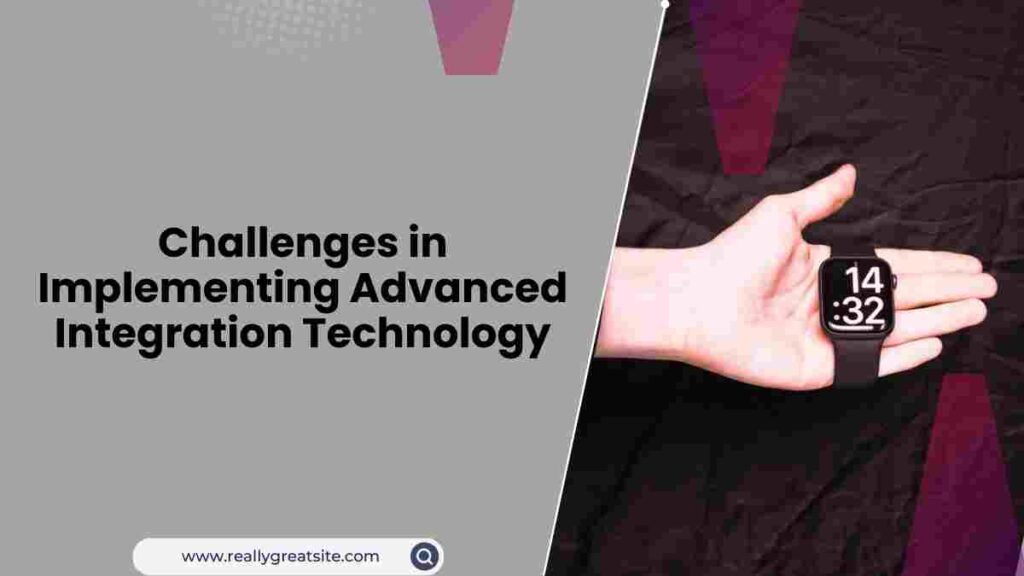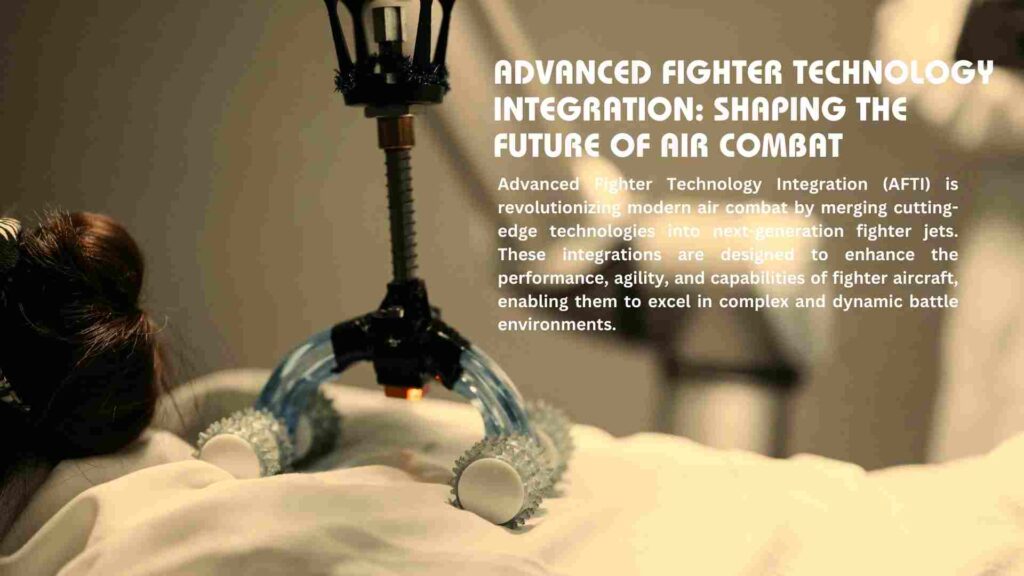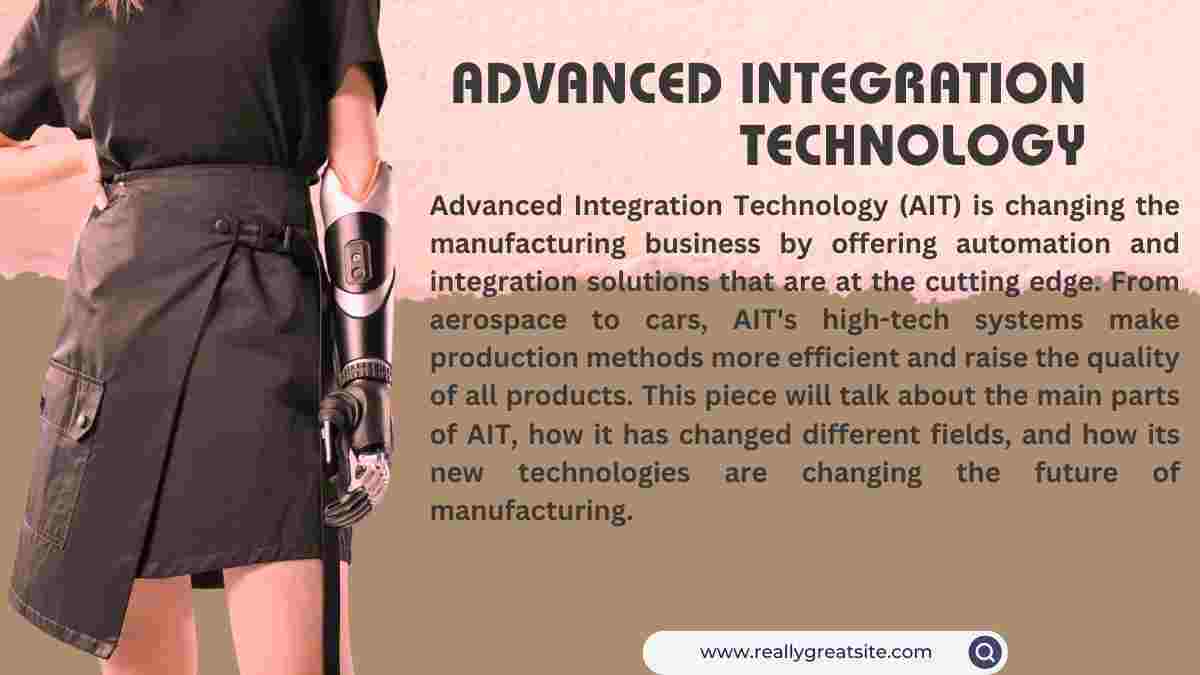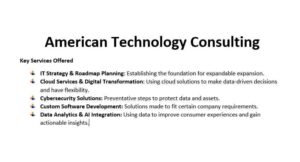Automation, robotics, AI, and data-driven solutions for higher output are all examples of advanced integration technology. That can changed the way things are made.
Contents
- 1 Introduction
- 2 What is Advanced Integration Technology.?
- 3 Applications of Advanced Integration Technology Across Industries
- 4 The Future of Advanced Integration Technology
- 5 Challenges in Implementing Advanced Integration Technology
- 6 Key Technologies Driving Advanced Integration
- 7 Best Practices for Implementing Advanced Integration Technology
- 8 The Role of AIT in Industry 4.0
- 9 Advanced Fighter Technology Integration
- 10 Advanced Integration Technology in Michigan
- 11 Conclusion
Introduction
Advanced Integration Technology (AIT) is changing the manufacturing business by offering automation and integration solutions that are at the cutting edge. From aerospace to cars, AIT’s high-tech systems make production methods more efficient and raise the quality of all products. This piece will talk about the main parts of AIT, how it has changed different fields, and how its new technologies are changing the future of manufacturing.
What is Advanced Integration Technology.?
Advanced Integration Technology is a complex mix of automation, robotics, software, and data analytics that makes it possible for production processes to work together without any problems. Businesses can use these solutions to manage production lines, which improves accuracy and cuts down on human error. This makes the business more productive and saves money. AIT can be used for many different things. Such as:
- Robotics and Automation Systems: These systems run repetitive jobs automatically, which makes them more accurate and speeds up production.
- Digital Twins: Manufacturers can keep an eye on and improve production in real time by using virtual versions of physical systems.
- Data Integration and Analytics: AIT tools gather and examine huge amounts of data to help people make better choices and find areas where they can be more efficient.
- Custom Integration Solutions: These are systems that are made to fit the specific needs of different fields, like electronics, aerospace, and automobiles.
Key Benefits of AIT in Manufacturing
1. Increased Efficiency and Productivity
By automating complicated chores and reducing the need for manual labor, AIT solutions help manufacturers cut down on production times. This higher level of efficiency means shorter production processes, less downtime, and better use of resources.
2. Enhanced Precision and Quality Control
Robotics and automation systems make sure that every step of the production process is done perfectly. This cuts down on mistakes and makes sure the end product is more consistent, which makes customers happier.
3. Cost Savings and ROI
AIT systems can cost a lot to buy at first, but they are worth it in the long run because they save money on running costs, cut down on waste, and boost output. When companies optimize production and cut down on worker costs, they can get a faster return on investment (ROI).
4. Scalability and Flexibility
AIT makes it easy for manufacturers to grow their businesses and adapt to changing market needs without having to make big changes to their systems. Businesses can grow while still being cost-effective and quick to respond, thanks to this versatility.
Applications of Advanced Integration Technology Across Industries
1. Aerospace:
AIT is very important to aerospace production because it automates the assembly of complicated parts like fuselages and wings. High-precision robots make sure that every part is put together exactly as planned, which improves safety and dependability.
2. Automotive:
AIT systems make it easier to make parts for cars, which makes sure that the assembly line is always consistent and accurate. This speeds up output and makes the quality of the cars better.
3. Electronics:
Electronics AIT helps companies that make electronics make more accurate parts like microchips and circuit boards that are very complicated. This level of accuracy is necessary to make the high-quality products that people want.
The Future of Advanced Integration Technology
As more and more industries adopt Industry 4.0, advanced integration technology will play an even bigger part. As AI, machine learning, and the Internet of Things (IoT) become more popular, AIT will make it possible for even smarter, data-driven automation solutions. These technologies will make workplaces smarter so that machines can talk to each other and work together more easily. This will push the limits of innovation and efficiency.
Challenges in Implementing Advanced Integration Technology

Even though advanced integration technology has a lot of benefits, makers have to deal with a number of problems when they try to use it:
1. High Initial Costs
Putting in place advanced automated systems and unique integration solutions can cost a lot of money up front. Smaller producers may not be able to afford this cost, but the long-term return on investment usually makes it worth it.
2. Training and Skill Requirements
When AIT is introduced into an industrial setting, it usually needs a highly skilled workforce that can run and take care of complex systems. It might be hard for manufacturers to train their current workers or find experts in robotics, AI, and data integration.
3. Integration with Legacy Systems
A lot of manufacturers are still using old systems that might not work with new AIT options. It can be hard to make old systems and new technologies work together smoothly. This needs unique engineering solutions and thorough data migration plans.
4. Cybersecurity Threats
As more and more AIT solutions depend on interconnected systems and IoT devices, the risk of cyber attacks grows. It is very important to keep sensitive data, intellectual property, and important processes safe from cyberattacks.
5. Maintaining Flexibility in Production
Automated systems are more efficient, but they need to be programmed and set up, which can make them less adaptable in production settings that change quickly. Automation is important for manufacturers, but they also need to be able to quickly change their products or respond to changes in the market.
Key Technologies Driving Advanced Integration
Advanced integration technology is based on a few main technologies that make it possible for it to change many industries:
1. Industrial Robotics
Robots that do repetitive jobs quickly and accurately are the backbone of automation. Robots, like robotic arms that put together parts of cars and self-driving drones that check out workplace equipment, make things more efficient and less likely to go wrong.
2. Machine Learning and Artificial Intelligence
AI and machine learning systems look at huge amounts of data to find the best ways to run production lines right now. By learning from operational data, these systems can figure out when they need to be maintained, get rid of bottlenecks, and improve the flow of output as a whole.
3. The Internet of Things (IoT)
IoT makes a smart production ecosystem by linking machines, devices, and sensors. IoT-enabled factories can check on the state of their equipment, keep track of their inventory in real time, and change how they do things based on data from connected devices, which makes the whole process more efficient.
4. Analysis of Big Data
Big data analytics are used by advanced integration technology to get useful insights from the huge amounts of data that are created during production. This helps businesses improve their supply lines, guess what customers will want, and run their businesses more efficiently.
5. Digital Copies
Digital twins are computerized copies of real systems. That let makers test, simulate, and keep an eye on processes as they happen. By giving a full picture of production processes and letting repair be planned ahead of time. These digital models help people make better decisions.
Best Practices for Implementing Advanced Integration Technology
To make sure that AIT is implemented correctly and that producers get the most out of it, they should follow these best practices:
1. Conduct a Thorough Needs Assessment
Do a full analysis of your present manufacturing processes before putting AIT into place. Find places where things aren’t working as well as they could and where automation can add the most value. This will help you make sure that the technologies you buy meet your specific wants.
2. Invest in Scalable Solutions
Pick AIT tools that can expand as your company does. Scalable solutions let you add new products or grow your business without having to completely rebuild your system.
3. Prioritize Cybersecurity
Because so many systems and data are linked to each other, cybersecurity should be a top concern. To keep your systems safe from possible threats, you should buy strong security tools like encryption, firewalls, and tracking software.
4. Train and Upskill Your Workforce
AIT simplifies a lot of tasks, but people’s knowledge is still very important. Invest in training programs to make sure your employees have the skills they need to run, maintain, and fix problems with complex systems.
5. Choose a Trusted Integration Partner
Work with AIT companies and integration partners who have been in business for a while and know how complicated your industry is. These partners can help you come up with unique solutions, make sure they work well with other systems, and offer ongoing support.
The Role of AIT in Industry 4.0
Industry 4.0’s ongoing digitization and automation, a significant part of which is Industry 4.0 itself, involve the use of advanced integration technology. Smart factories are part of Industry 4.0. In these factories, tools, devices, and systems talk to each other and work together using data and analytics. AIT allows manufacturers to:
- Automate complex tasks and processes with minimal human intervention.
- Use data to make real-time decisions, improving productivity and reducing waste.
- Enhance communication between systems for more streamlined and efficient production lines.
Industry 4.0 will continue to grow thanks to AIT, which will make it possible for even more automation, flexibility, and efficiency in all fields.
Advanced Fighter Technology Integration

Advanced Fighter Technology Integration (AFTI) is revolutionizing modern air combat by merging cutting-edge technologies into next-generation fighter jets. The integrations enhance performance and agility. And capabilities of fighter aircraft, enabling them to excel in complex and dynamic battle environments.
Key advancements include:
- 1. Stealth Technology: Enhanced radar-evading capabilities, making fighters nearly invisible to enemy detection.
- 2. Artificial Intelligence (AI): AI-driven systems improve decision-making, target acquisition, and autonomous operations during combat.
- 3. Advanced Avionics: Integrated sensors, data fusion, and communication systems provide pilots with real-time battlefield awareness and control.
- 4. Hypersonic Capabilities: High-speed propulsion technologies allow aircraft to travel at speeds over Mach 5, increasing their ability to strike targets swiftly.
- 5. Enhanced Weapons Systems: Precision-guided munitions, laser weaponry, and electronic warfare capabilities expand the fighter’s strike potential.
These innovations are transforming air superiority by creating highly versatile, resilient, and intelligent aircraft capable of operating in both offensive and defensive roles. Advanced Fighter Technology Integration ensures that modern air forces remain at the forefront of global security, responding effectively to evolving threats and mission demands.
Advanced Integration Technology in Michigan
Michigan, known as the heart of the American automotive industry, is embracing Advanced Integration Technology (AIT) to revolutionize its manufacturing processes. AIT combines cutting-edge robotics, automation, and data analytics to enhance efficiency, precision, and scalability in various industries, including automotive, aerospace, and electronics.
In Michigan, AIT is transforming how companies design and produce goods, offering benefits such as:
- Automation of Complex Tasks: Robotics and AI systems streamline production lines, reducing labor costs and increasing output.
- Precision and Quality Control: Advanced sensors and data integration help maintain consistent product quality and minimize defects.
- Efficiency in Operations: AIT solutions optimize supply chains, production schedules, and resource allocation, driving down operational costs.
- Workforce Evolution: Manufacturers in Michigan are upskilling their workforce to operate and maintain sophisticated AIT systems.
As Michigan continues to lead in manufacturing innovation, Advanced Integration Technology is playing a key role in keeping the state at the forefront of the global industrial landscape, enhancing competitiveness and boosting economic growth.
Conclusion
Advanced Integration Technology is transforming the manufacturing landscape by offering powerful automation and integration solutions that drive efficiency, precision, and cost savings. As industries evolve, AIT will continue to play a critical role in enabling companies to stay competitive and meet the growing demands of the global market. Embracing AIT is not just a step forward—it’s a leap into the future of manufacturing.
Must Read this:








